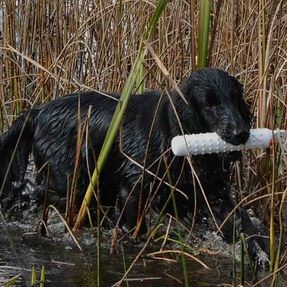History and Origin: One of the earliest recognizable retrieving Breeds c.1800, but not the oldest of the retriever breeds (The Curly-Coated Retriever holds that honour). Few records exist of the early development of any retrievers. It is usually the St. John’s Dog (from Newfoundland) that is considered to be the originator from which the various retrievers were developed. The St. John’s Dog was crossed with a Curly Water Spaniel to produce the Curly-Coated Retriever (taller and heavier than the Flat-Coat). Several years later the St. John’s dog was bred to black Setters producing retrievers called the Wavy-Coated Retriever that possessed a heavy wavy coat. (circa 1850) Later the name was changed to the Flat-Coated Retriever. The first Flat-Coated Retriever standard was published in 1885. They were first classified as a separate Retriever breed at Crufts Dog Show (England) in 1905. Recognzed by the AKC in1915.
General Appearance: A strong and substantial dog showing elegance and refinement. “Power without lumber and raciness without weediness”. Distinctive features are the silhouette (moving as well as standing) level topline, deep long rib cage creating the impression of a a blunt triangle. Long clean substantial head, black or brown nose, depending on body colour ,strong bone, almond shaped eyes, bite scissors to level, ears dropped and carried close to head, long tail. An elegant breed. Size: males 23-24 inches Females 22-23 inches weight 60-70 pounds
Coat and Colour: Coat black or brown ( liver) Coat is of moderate length and lies flat although some waviness is permissible. Dogs in full coat have thickly feathered ears, chest, back of forelegs, thighs and underside of tail. Feathering is NOT excessively long. Tidying of whiskers, ears, feet and tip of tail is the only grooming necessary. Yellow pups occur occasionally in some lines but are not preferred and should not be registered or bred.
Feeding: A high quality balanced diet fed twice daily.
Training and Obedience: eager and willing in performance sports, which include obedience, field work, scent detection, rally, dock diving, agility and more.
Temperament: The flat-coat has a confident, happy and outgoing attitude (characterized by a wagging tail). They are known as the “Peter Pan” of the dog world. An amazing versatile field dog and great family companion.




